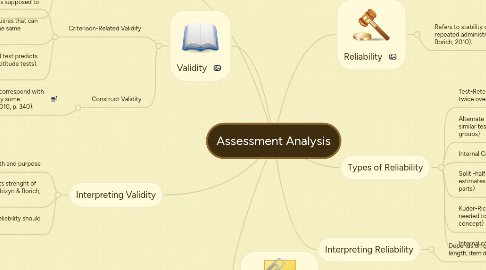Assessment Analysis
by nancy schumacher

1. Content Validity
1.1. Assessed by comparing a test item with objectives
1.2. Does not produce a numerical estimate
1.3. Used to figure out if a test measures what it is supposed to measure.
2. Validity
2.1. Criteriaon-Related Validity
2.1.1. Correlates test scores with an external standard or criterion (Kubizyn & Borich, 2010, p. 340).
2.1.2. Concurrent - meausres that can be administered at the same time
2.1.3. Predictive - referes to how well test predicts some future behavior (good for aptitude tests). (Kubizyn & Borich, 2010, p. 340).
2.2. Construct Validity
2.2.1. Determined by finding if test results correspond with socres on other vairables as predicted by some rationale or theory. (Kubizyn & Borich, 2010, p. 340).
3. References:
3.1. Kubiszyn, T. & Borich, G. (2010). Educational testing & measurement: Classroom application and practice (9th ed.). John Wiley & Sons, Inc., Hoboken, NJ.
4. Interpreting Validity
4.1. Adequacy depends on strength and purpose
4.2. Group variability affects strenght of validity coefficient (Kubizyn & Borich, 2010).
4.3. Relevance and reliability should be considered
5. Types of Reliability
5.1. Test-Retest (same test given twice over period of time)
5.2. Alternate form estimates (two similar tests given to similar groups)
5.3. Internal Consistency (see below)
5.4. Split -half and odd-even estimates (tet divided into two parts)
5.5. Kuder-Richarson (only one test needed to estimate measure of concept)
5.6. Internal consistency (speeded tests)
6. Reliability
6.1. Refers to stability of test score over repeated administrations (Kubizyn & Borich, 2010).
7. Interpreting Reliability
7.1. Depends on group size, test length, item difficulty


